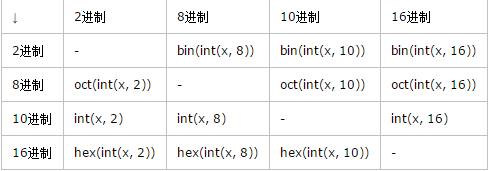使用Python内置函数:bin()、oct()、int()、hex()可实现进制转换。
先看Python官方文档中对这几个内置函数的描述:
bin(x)
Convert an integer number to a binary string. The result is a valid Python expression. If x is not a Python int object, it has to define an __index__() method that returns an integer.
oct(x)
Convert an integer number to an octal string. The result is a valid Python expression. If x is not a Python int object, it has to define an __index__() method that returns an integer.
int([number | string[, base]])
Convert a number or string to an integer. If no arguments are given, return 0. If a number is given, return number.__int__(). Conversion of floating point numbers to integers truncates towards zero. A string must be a base-radix integer literal optionally preceded by ‘+’ or ‘-‘ (with no space in between) and optionally surrounded by whitespace. A base-n literal consists of the digits 0 to n-1, with ‘a’ to ‘z’ (or ‘A’ to ‘Z’) having values 10 to 35. The default base is 10. The allowed values are 0 and 2-36. Base-2, -8, and -16 literals can be optionally prefixed with 0b/0B, 0o/0O, or 0x/0X, as with integer literals in code. Base 0 means to interpret exactly as a code literal, so that the actual base is 2, 8, 10, or 16, and so that int('010', 0) is not legal, while int('010') is, as well as int('010', 8).
hex(x)
Convert an integer number to a hexadecimal string. The result is a valid Python expression. If x is not a Python int object, it has to define an __index__() method that returns an integer.

#10进制转为2进制 >>> bin(10) '0b1010' #2进制转为10进制 >>> int("1001",2) 9 #10进制转为16进制 >>> hex(10) '0xa' #16进制到10进制 >>> int('ff', 16) 255 >>> int('0xab', 16) 171 #十进制转为八进制 >>print("%o" % 10) >>12 #16进制到2进制 >>> bin(0xa) '0b1010' #10进制到8进制 >>> oct(8) '010' #2进制到16进制 >>> hex(0b1001) '0x9'